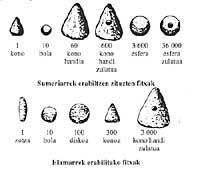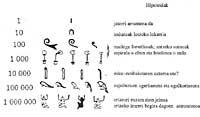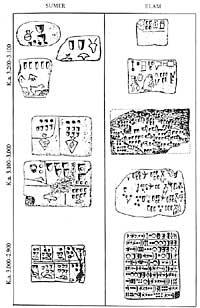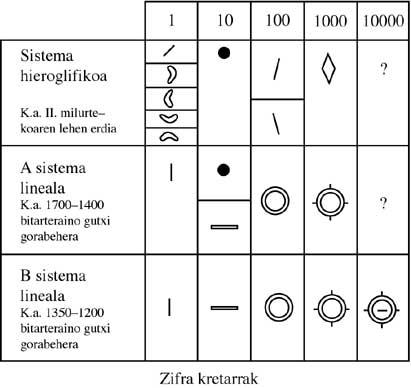History of figures (II)
Invention of figures
Matching the figures was not able to escape, but the result of a long development. 5,000 years ago, advanced companies felt compelled to carry out numerous economic operations and realized that they had to keep their results. To do this, they thought of representing the numbers using graphic symbols, that is, they invented the figures. But how was it done?
When they realized the use of the base, songs of different sizes were taken and depending on their size different values were given: unit to the stony, ten to the small stone, percentage to the normal stone, etc. But they did not always find the right stones. To improve the system the stones were replaced by clay objects of different sizes and shapes. This type of chips have been found in numerous deposits in the Middle East. However, this improved system did not meet all the required requirements.
BC. In the year 3,500, approximately, Sumer and Elam were very advanced peoples, with a growing need to preserve the results of sales, purchases, inventories, distribution, etc. They put the necessary tokens into a clay sphere to sign the deals. Once closed the traffickers engraved their stamp on the sphere. All this was done before a narrator, who kept the sphere.
However, this process was very uncomfortable, since when one wanted to know the interior the sphere had to be broken.
BC. By the year 3,300 accountants became aware of the problem and it occurred to them to symbolize the tokens with different cuts. The appearance of the cuts was that of the chips. The cuts were made on the outside of the dial, but also kept the tiles inside.
BC. In the year 3,250 approximately the sphere and the inner tiles stopped being used and were replaced by clay boards. At first they were circular boards, which later became squares.
At this point, we must say that they did not know how to write at that time (write as we write now). Therefore, the figures appeared before the letters.
These tables lacked something, the object of treatment. These began to appear around the year 3,200, beginning the written accounting. Ivory wedges were used for the drafting of the conventions, with one pointed end and one cylindrical end.
This pictographic system is not yet what we call writing. In the next stage the images gained more value. If at first a leg indicated the leg, then walking, standing, running,... had also meanings. This is called ideography. This system facilitates the combination of two or more images. These symbols do not represent sounds, but we are on the threshold of writing.
BC. From the years 2,800-2,700 objects are represented by phonetic values, that is, hieroglyphics are used. For example, on the supportive boards the image of the oven is used to express the NE sound, which is the name of the oven. Another, the name of the arrow is YOU. As the name of life is also YOU, an arrow will indicate life. This is the origin of our writing. As you know, writing has, say, the same origin of the figures.
Nearby, at the time of the Pharaohs, Egyptians invented writing and the written numbering system on their own. BC. This occurred around 3,000 years. Egypti hieroglyphs are based on the flora and fauna of the Nile area.
On the other hand, the hieroglyphic numbering system is completely different, since they used base ten from the beginning. To express a number they repeated as many times as needed.
BC. XXVII. From the 20th century, the symbols of the same unit were written in several lines to facilitate their reading. Egypti also used hieroglyphs to express sounds. This is the origin of the symbols they used to write numbers.
Eleven or twelve centuries later, another advanced civilization had the opportunity to invent writing and figures. This occurred in the Minoan civilization of the island of Crete. As in previous civilizations, advances in all areas led to the invention of accounting and written memory. This occurred around 2000.
The Cretans created three different scriptures:
- hieroglyph (2,000-1,600)
- The linear call A (1.700-1.400), derived from the previous one but with more schematic images.
- The so-called linear B (1.350-1.200), obtained by reworking the previous one, is used to write the mycenic language and not the minon.
The cretic system was very similar to the most Egyptians, since in addition to using base ten, the special symbol joined only the textures of the tenth. Throughout these years (2000–1200) the symbols of the numbers were modified maintaining the same cretan principle of numbering.


At another end of the world, twenty-five centuries later, the Aztecs obtained the same results, based on conditions analogous to the initials. Aztec writing was imaginative, a mixture of ideographic and phonetic writings. That is, some symbols represented objects and other sounds.
On the other hand, the numbering system of the Aztecs was twenty bases and had only four figures.
All this has been known thanks to the Codex sculptures, mostly written when the Spaniards arrived.
It is surprising that such distant civilizations have obtained similar results, both in time and space. The reason for this has already been mentioned: in all cases the initial conditions were identical or very similar.
The Greeks, at first influenced by the Mycenaics, used the Cretaceous system, maintaining its principle.
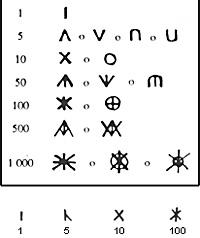

But as in the egyptiar, cretan or Aztec system, its simplicity was its greatest barrier. For example, writing the number 7699 required twenty symbols. This prompted the Greeks to add fill figures. BC. VI. From the 20th century the numbers 5, 50, 500, 5000,... were assigned a special symbol. At the same time the symbols of the figures were replaced by letters of the alphabet, the first letters called numbers. That is, the experts did what they call acrophony. For example, ten (10), which was expressed with the first letter of the DECA. Now they only needed fifteen symbols to write 7699.

Roman figures were born centuries before Roman civilization. They were similar to the figures of the Oscos, Equos, Umbros and, above all, of the Etrurean peoples. In addition to these villages, the Tuscan, Dalmacian, Magi, Swiss, Austrian, Germanic or Scandinavian peoples achieved similar figures through sangria.
The Etruscans used before the Romans the additive and subtractive principle. To indicate the first four numbers, as many lines are made as necessary.

for 5 write only write V and no III IV, six VI and no IIII V I. In the same way, instead of writing four IIII VII it was written III IV, that is, IV; nine IIIIVIIII XII are replaced by IIIIVIII IX II.
The origin of the figures of all these villages, without lips, is found in the old piers. Later, the Roman symbols developed until they got the appearance of the Roman figures we know now.

With the initial seven symbols only numbers less than 5000 could be represented. In times of the Republic, the special emblem was assigned to four other numbers, 5000, 10,000, 50,000 and 100,000. In addition, they established various conventions on writing. One of the following was to multiply by a thousand the value of any symbol written under a line:

Another multiplied by a hundred thousand the symbol entered into an incomplete rectangle:

The Romans used many other conventions, but if they did not facilitate the system it was complicated
were the origin of many mixtures.
These systems, in general, Greeks and Romans (and similar to these) should be considered a setback, as both writing and operations complicated.



